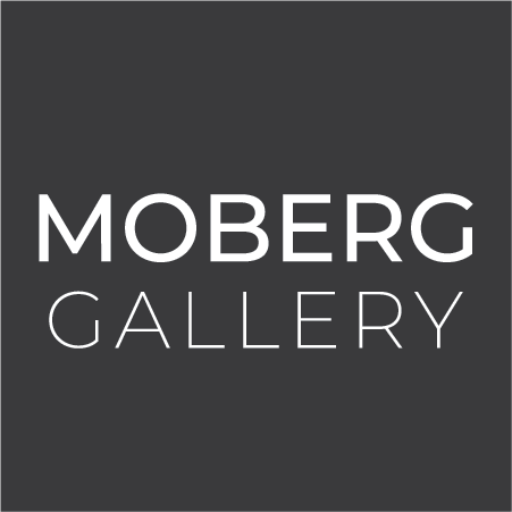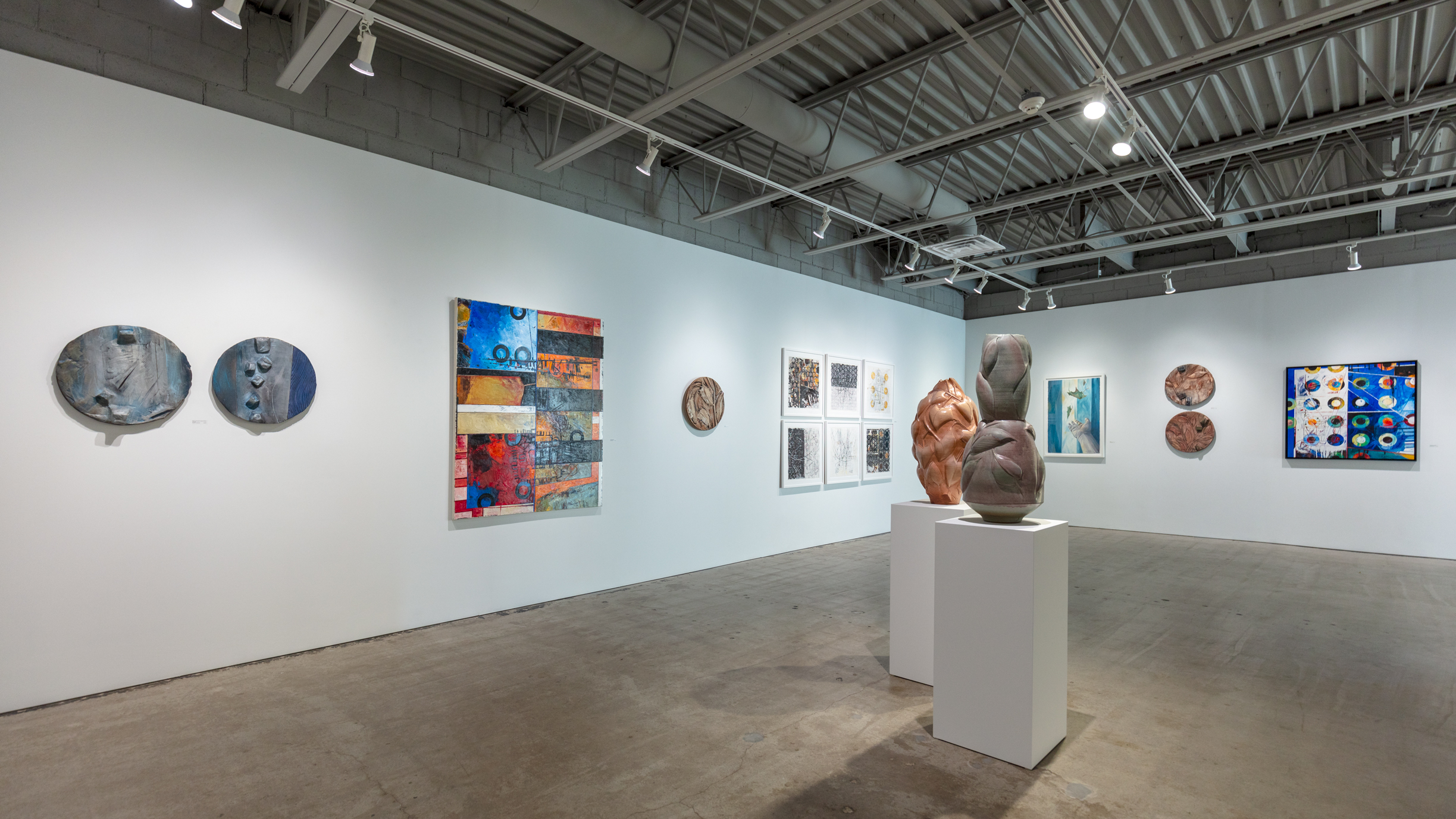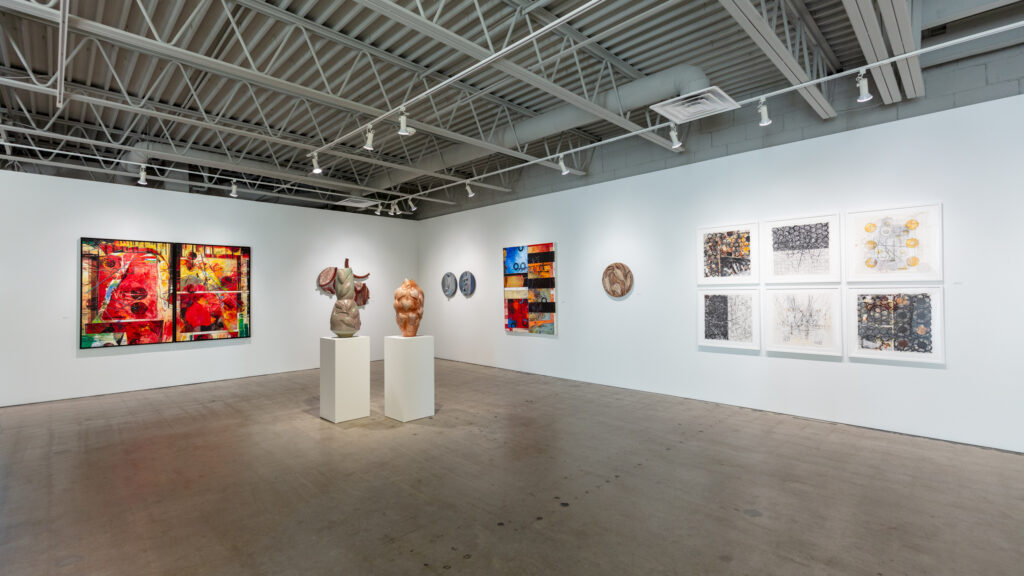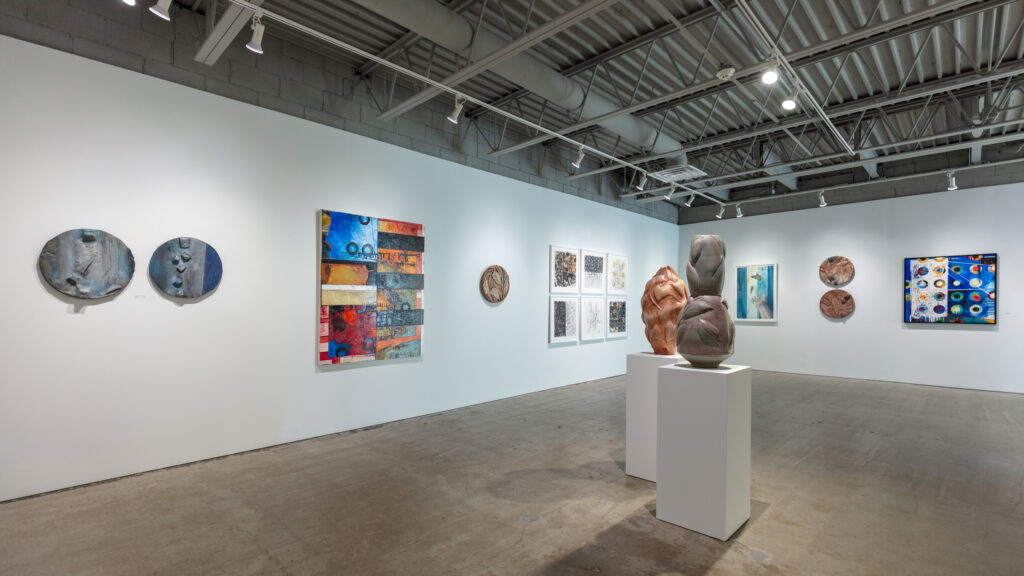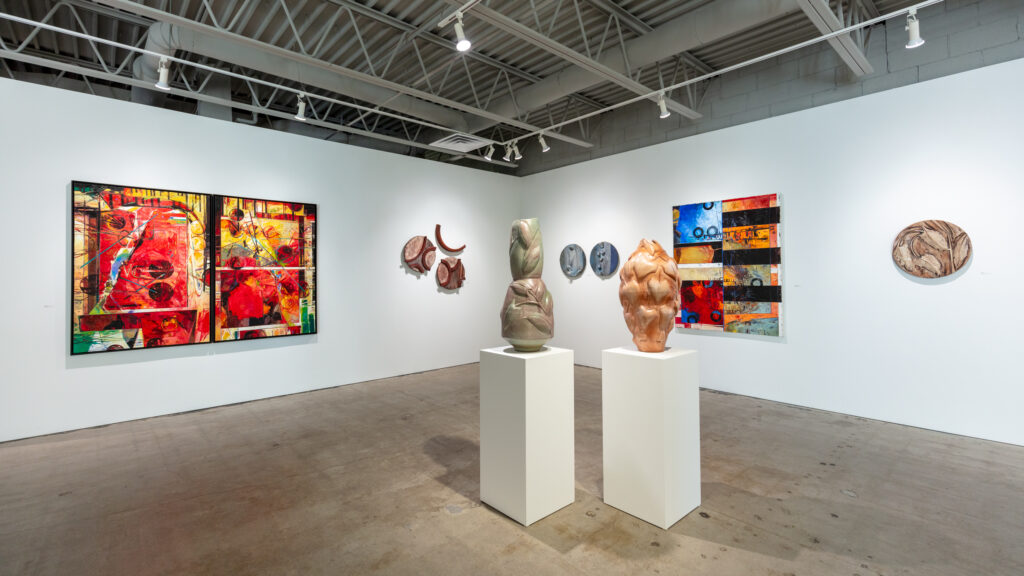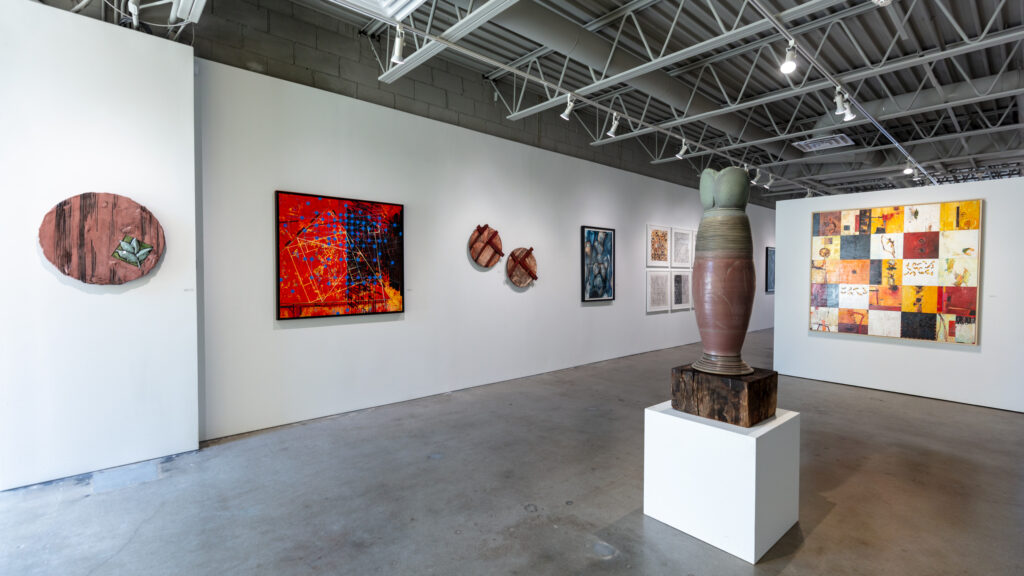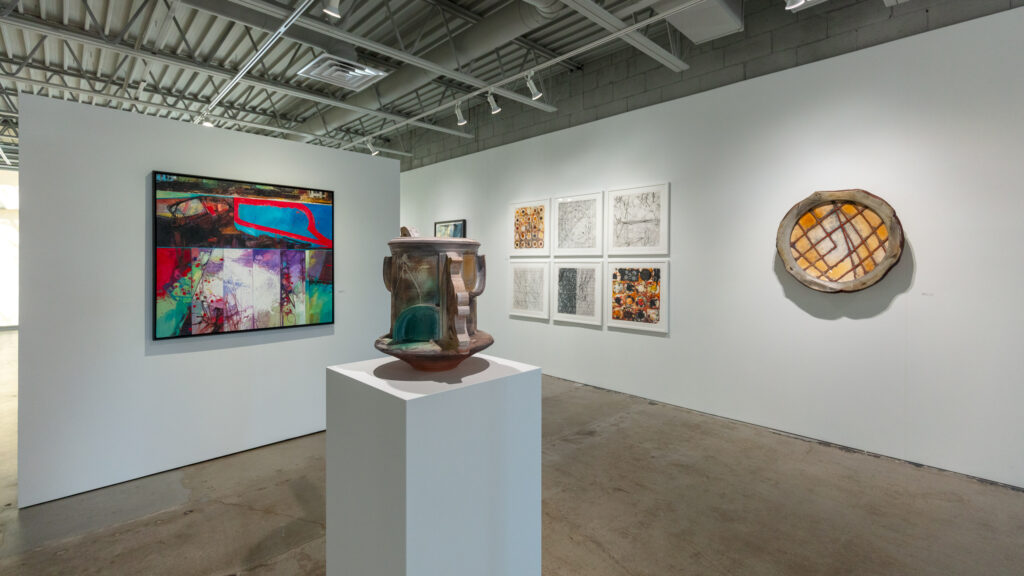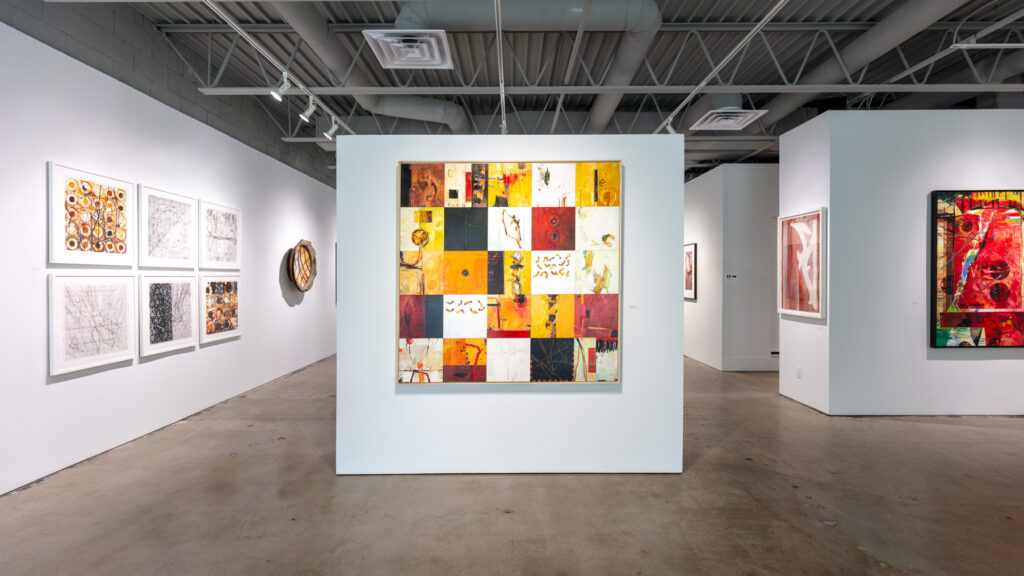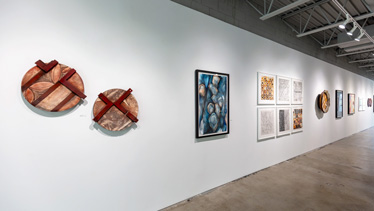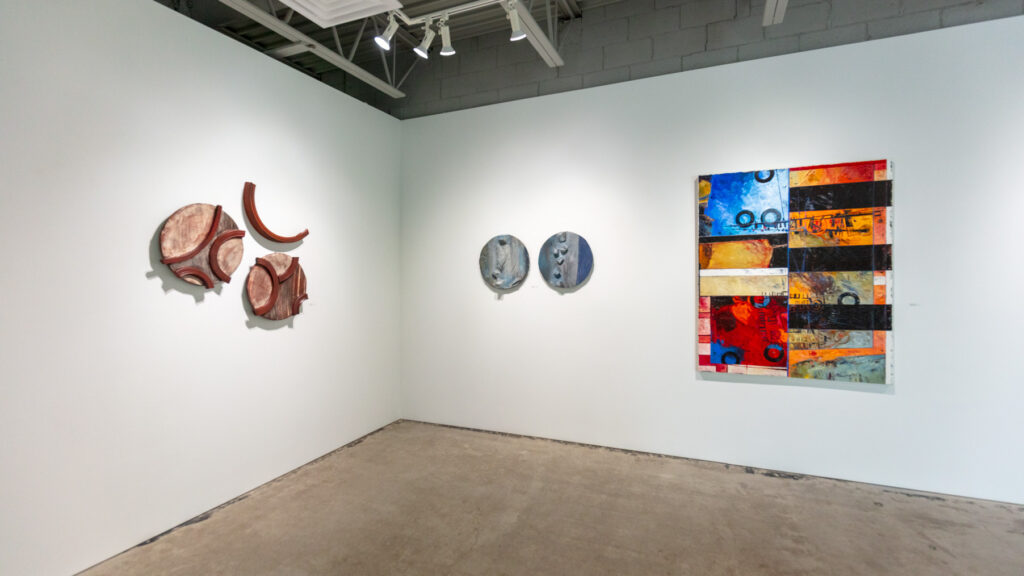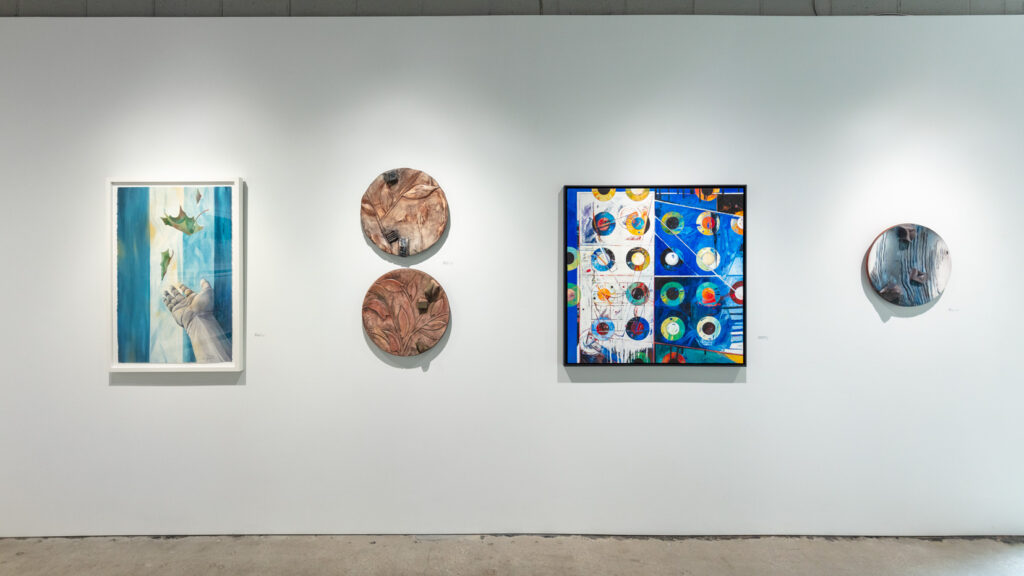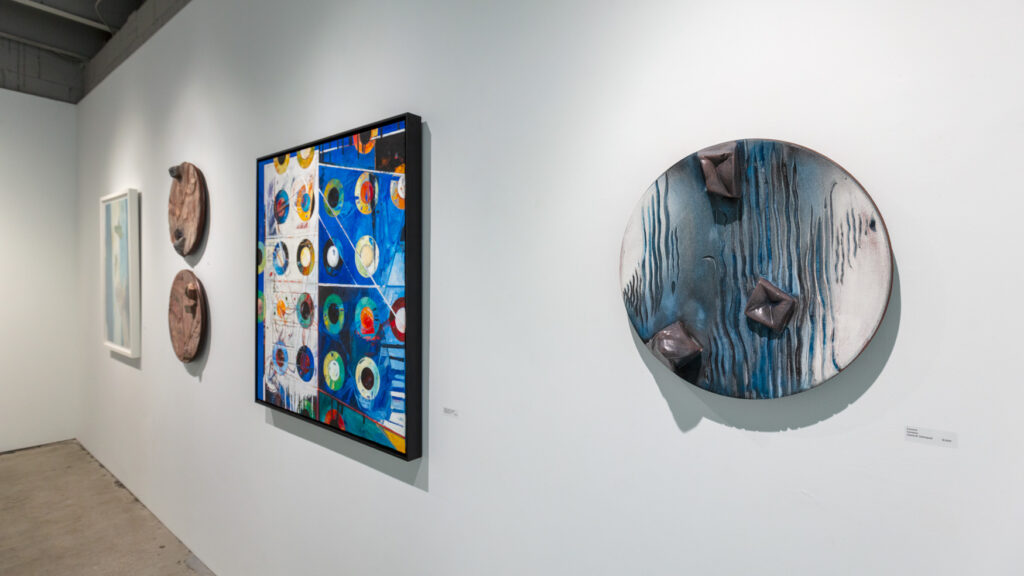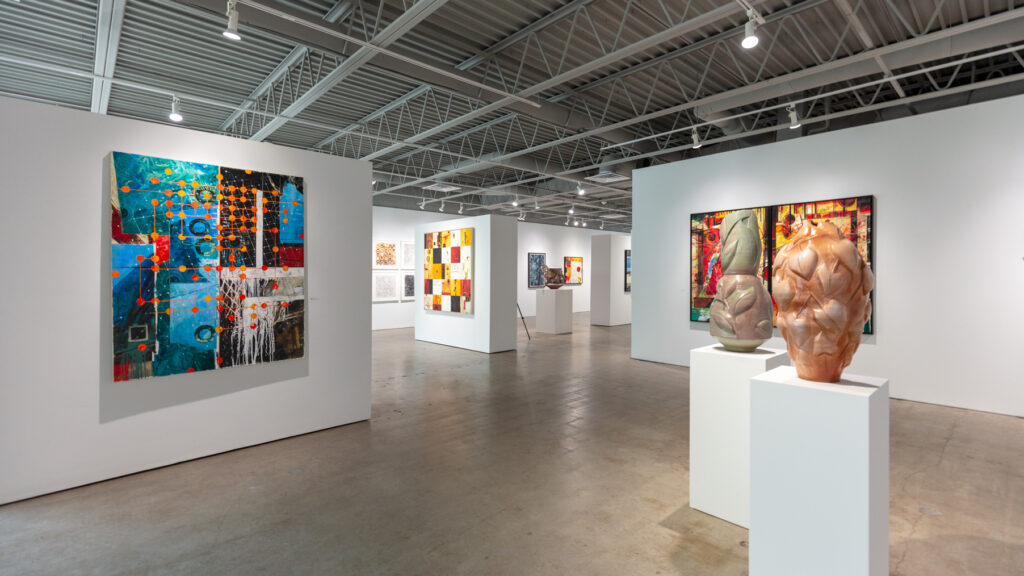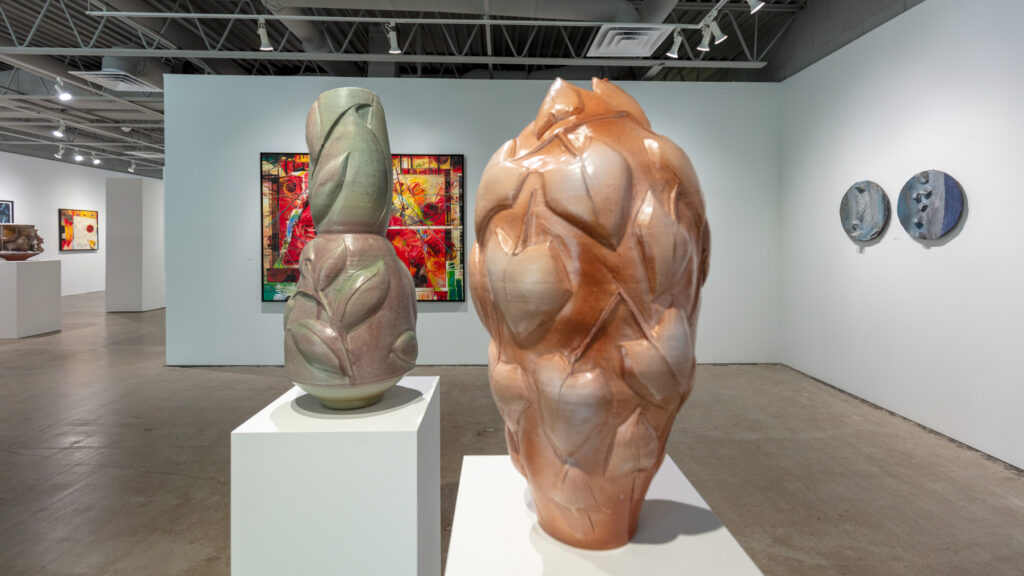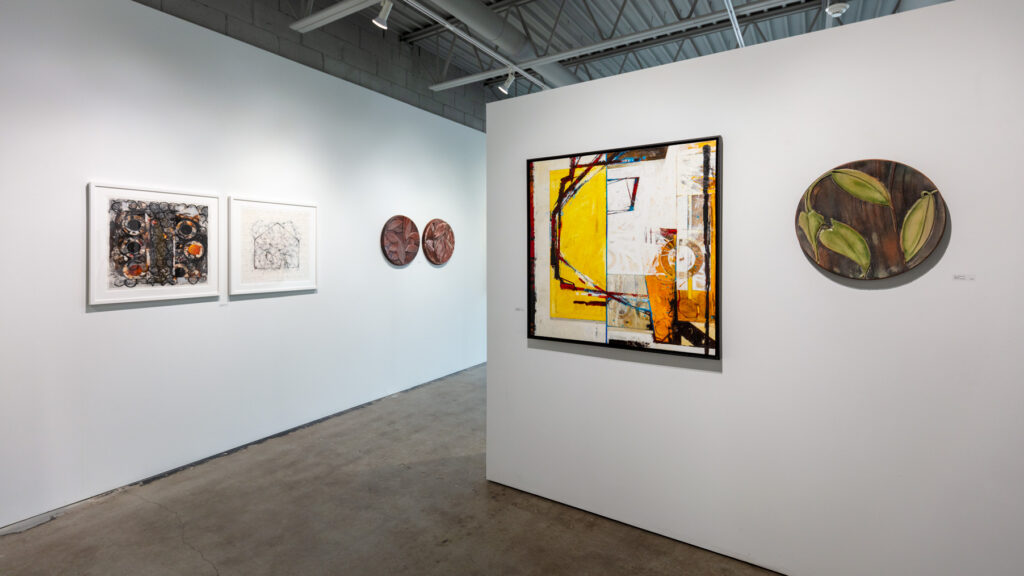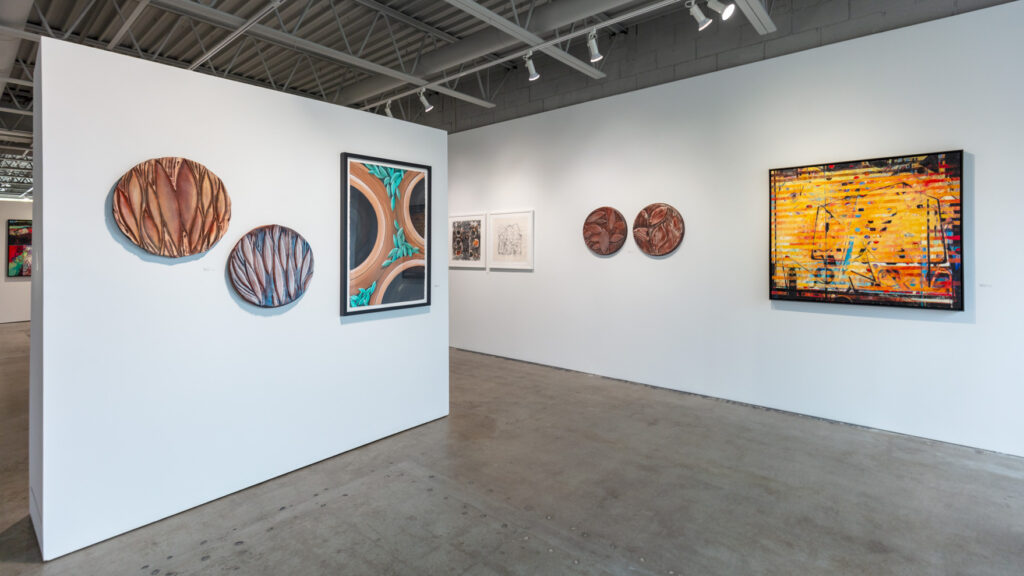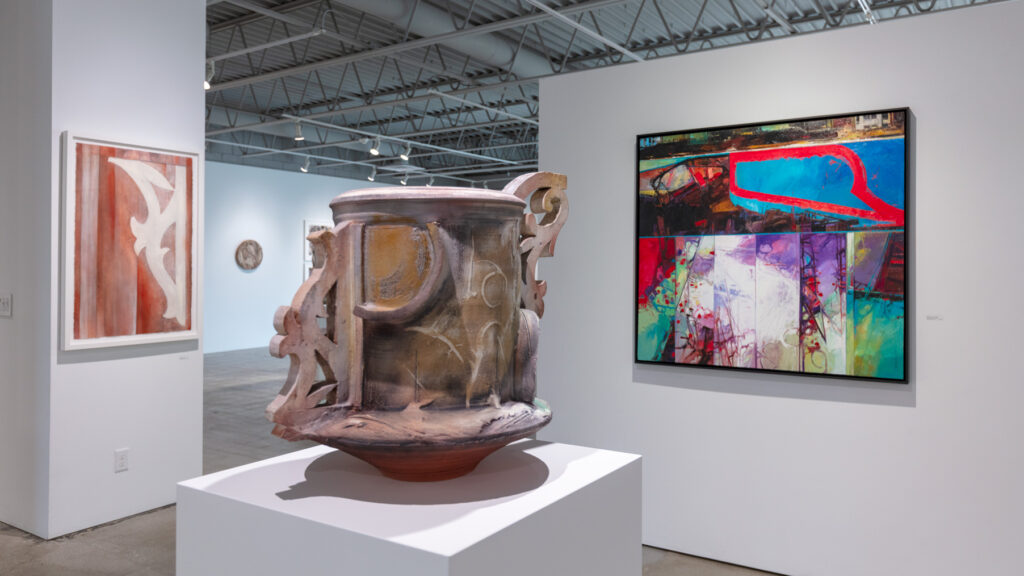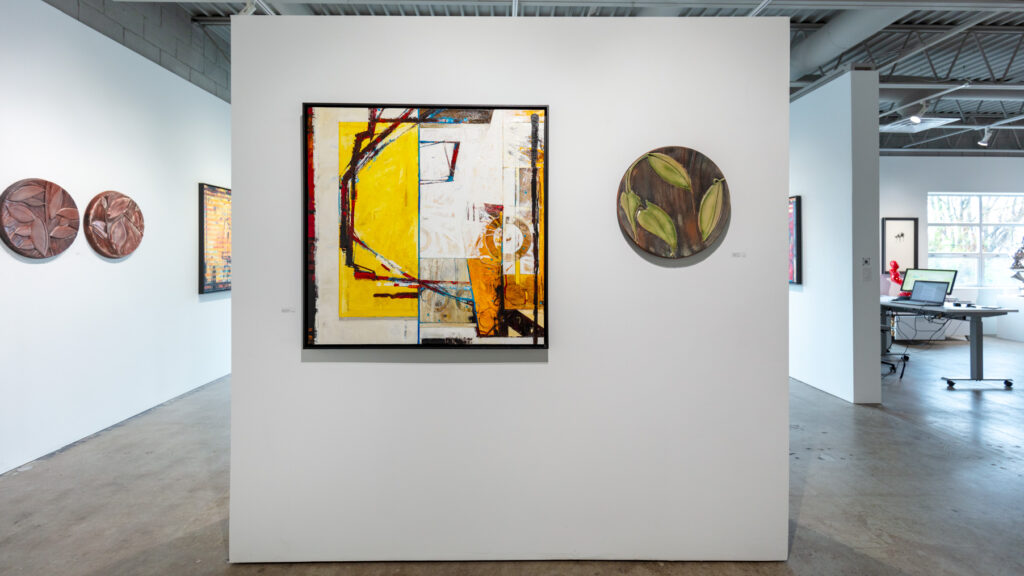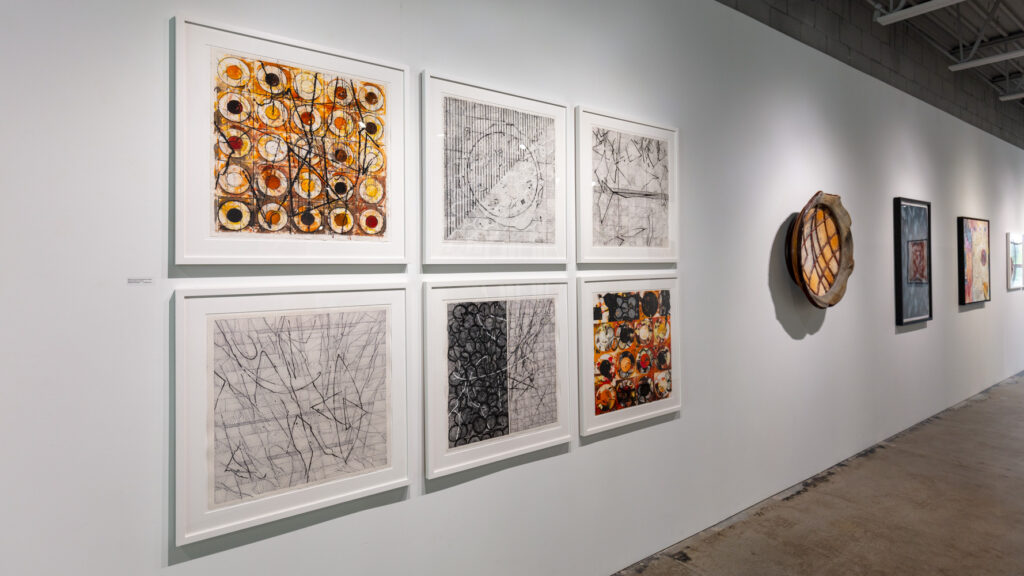TEXT BY MICHAELA MULLIN | VIEW IMAGES
Artists and long-time friends, David Dahlquist and Wendell Arneson, have come around again to show new work. Dahlquist is making sculptures but has also been painting recently, and Arneson’s new abstract works distill and expand natural elements. Both artists are visual storytellers, and the words associated with their narratives also often get incorporated. The new large sculptural vessels Dahlquist has created stand tall and curve their way through the audience’s view. Leaf-like forms in relief wrap around the soft natural-colored glazes. In stunning contrast, Arneson’s palette elucidates the vibrancy of traveling land and waterways. Together, these two artists have put together an exhibit of multiple mediums, decibels, and spatial siting.
David B. Dahlquist is known for his large ceramic sculptures, both 2 and 2-deminsional: solid yet moving, fixed yet wrapped in growth. Those pieces are in this exhibit, but the new paintings of Dahlquist’s deserve front stage here. A few of the paintings on view: “Olive Jars,” “Falling,” “Nightshade,” incorporate nature, but in such varied ways.
“Olive Jars” is an aerial view of just that—three partial circles interspersed with olive leaves. The green of these small gatherings between the browns of the jars and the blacks of potentially voided space, offer a conceptual everything: holding, emptiness, life. The concentricity of the circles brings the viewer in and out of the piece gently and the composition fills the paper, edge to edge to edge to edge. It is a moment of sight, a thumbnail of observation, and it fills the mind.
“Falling” is a study in quietude and gravity. Two brown leaves fall downward to the bottom right of the painting, and the white, gray, and black background offer direction in vertical strokes. This minimal composition gives way for the viewer to contemplate the black lines that trace the fall of both dead leaves. Neither leaf touches the bottom of the paper; neither touches the other leaf; but the dark lines of trajectory cross. And the darker background where the leaves have assumedly traveled gives a depth to their existence.
“Nightshade” again fills up the surface space of the painting—blue and black leaves in repetition, in coverage. Even without the title, one knows they are witnessing a nighttime event. And that is what growing and flowering is—an event.
Dahlquist’s new ceramic works bring their usual sensuous organicism. Two large vessels included in the exhibit, “What We Leave Behind” and “Arms Around You,” are examples of the natural embracing that happens in his work. In the former, the soft rustic brown of the work gradates around vining heart-shaped leaves. The opening at the top is small, as if the clay is closing in upon itself, sarcophagus as cocoon? The latter work is pinker, orange, emitting a soft glow. The vessel’s leaves are more fluid and long, reaching up to an opening which is larger and clearer. The work is a surrounding in cool clay, a warm encompassing of color, shape, and glaze.
Dahlquist’s wall sculptures, “Frames of Reference” and “Green Watercolor” are signature ceramic wall discs, the circles which Dahlquist recognizes as the make up of all things universal. Both pieces in “Frames of Reference” have right angles protruding from within to the outside of the circumference line, and one work incorporates a ceramic ampersand. For incorporating “else” is integral to the cumulative nature of life. More may be less, but there will always be more/different. “Green Watercolor” depicts four greening leaves that appear to have floated onto the surface of the work. They lay perfect, while offering a sheen, as if fallen rain has just coated them.
Wendell Arneson’s paintings are abstract cartography—paths to knowledge of new destinations.
“Waiting for Home” and “Map #2,” use deep color, with dots and lines to guide the eye. These are gridded composition that do not adhere—grid upon angled grid, creating a mesh of line and points of intersection over saturated reds, oranges, and black areas on the canvas in the former, and using different scaling of grid segments to offer more dimensionality in the lighter blue and white of “Map #2”. The webbing Arneson creates is catching. It draws in the viewer to follow the pathways, and it makes the audience want more. The compositions allow the dots to just touch the edges of the frames, and the continuity implied makes the work even larger in scale than their rectangular dimensions.
“Overlooking Dawn” puts the viewer in the middle of the reddest experience. The title implies an elevated vantage—an overlook. But the painting is so full, its striations of red, black, and blue create a horizon one feels they might actually meet. And the clear circles (not filled in dots this time), operate as lenses through which one may enter or see through. The full circles and connecting lines here create a sort of mechanism by which a new day begins.
“Autumnal Walk About,” is more straightforward and narrative than many of the other paintings in the show. Each small square cell holds an image like a story board. But the fact that the entire painting is square allows for the viewer to follow it in any direction one may like, and to realize the walk one takes in the Fall piece, offers abstract moments and varied moods. By no means is this tale “fixed.” It is open to the interpretation of its walker. Its season doesn’t change but the climate brought to the work by its audience changes its communication. Arneson’s use of white blocks amidst the yellow and red open the space, giving it light and movement.
There is something both playful and sobering about the works in Full Circle II—a mixture of melodic placement amidst an inevitable full life cycle. What is certain is that Dahlquist and Arneson continue to create thoughtful and thought-provoking work, and when exhibited together, one gets the best of two worlds, thus making a third world, together.
This exhibit is on view through Saturday, May 4, 2024.
Exhibit Images
